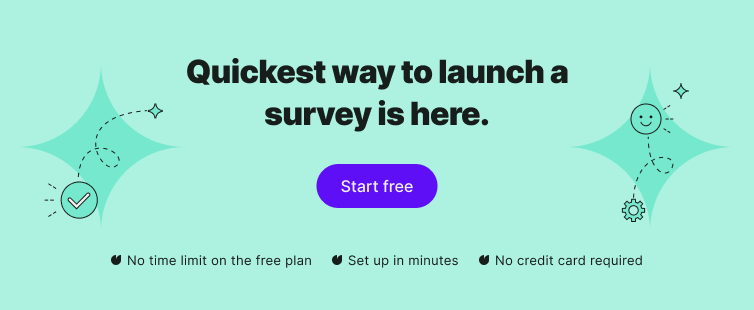When customers take the time out of their day and give feedback on your product or service, you need to say thank you.
It's easier said than done, though – especially if you're so-so when communicating with your customers.
Today, we'll show you how to thank your customers for feedback so they remember it and will happily share more of it in the future. We'll also share a feedback email you can use, so bear with us!

Why should you bother thanking for customer feedback
Simply because if you don't do it, your customers might not be willing to give you any feedback in the future.
We thank customers for their purchases, users for registering, or our colleagues for their performance reviews during a team meetings.
Why not thank them for their feedback, and, therefore, close the feedback loop?
It may seem like a small thing at first glance.
It, actually, is.
"Thank you for your feedback" is only five words, but those five words hold a lot of power.

And you can thank for it before you get it, too.
It's one of the most important phrases you can use, yet it's often a blind spot.
Responding to customer feedback promptly can show your customers that you care about their experience, no matter if they leave positive feedback or a pack of complaints.
And that sending a quick "thank you" can go a long way in maintaining strong customer relationships and encouraging them to give more feedback or advice.
How to thank for positive feedback: best tips
It's, naturally, easier to respond to a positive review and thank for a few kind words shared in a customer feedback email, for example.
But it's not only about the response itself.
You can also take some measures to ensure that customers remember your brand after they've left a positive review and, hopefully, become one of your brand advocates.
Here are a few ideas on how you can do just that:
- If the review is shared publicly, thank the customer on the same platform,
- Offer a discount or a coupon code to show appreciation for their input. To get inspired, check how popular software comparison platforms are doing so – they often offer gift cards as a "thank you" for even shorter reviews.
- Send a handwritten thank-you card to your customer – it's a personal touch that not each company bothers with these days but one that will make you stand out,
- Share the customer review on your company's social media and tag the customer in it,
- if you have an email list, include that customer review in your next newsletter – of course, upon your customer's approval.

These are all small things you can do with positive reviews.
Positive things are worth sharing, but you shouldn't get complacent – even if the customer feedback is positive, make sure you keep improving your services. Good reviews should be seen as an opportunity for self-reflection and a chance to improve what you're offering, as well as insights into any next project you may have.
How to thank for negative feedback: best tips
Responding to positive feedback is nicer than receiving and responding to negative feedback, but let us calm you down: it happens.
When you have a positive experience, you tell very few people. You're just a satisfied customer with little desire to leave positive feedback.
But if the experience is not up to par, you tell everyone – your friends, other customers, potential customers – and spray and pray with that company name everywhere. And if the brand isn't responding to your complaints within seconds, you're done.
Sounds familiar?
That's just how humans work.
For example, if you have a flight and you're transferred from point A to point B without any hassle, your first social media post might be published from your new destination, without praising the airline or writing a review.
But, if you have the same flight that is massively delayed, and overbooked, and you demand nothing but a full refund – your first social media post might be just about that, tagging the company name and encouraging other customers to never fly with that airline.
So, when you do get that negative feedback, don't despair.
It happens.
Use it to learn, grow, and match customer expectations.
Acknowledging a customer's anger or dissatisfaction can be a chance to turn them into one of your brand's biggest advocates.
All you have to do is show that you're listening and that their opinion matters to you by:
- responding professionally (and with a cold head – it's easy to be propelled by emotions, but not worth it),
- apologizing for the inconvenience,
- trying to find a solution together,
- following the LATTE rule introduced by Starbucks – listen, acknowledge, take action, thank, and explain,
- preparing a plan of action to make sure the same thing doesn't happen again – for example, additional training for your employees,
- turning a negative review into actionable learning – sometimes negative reviews give you more than a great review, as they show you in what areas you should work hard.
For example, a response in the form of a quick customer note is better than no response at all.
Further down, you'll find various social media and email templates you can use to respond to customers' feedback. Use them in practice and see which ones work best for your business, your customer service department, and anyone involved in customer communication.
Thank you for your feedback: examples and templates
Thanking for your customer feedback on social media
Customer feedback on social media can have two forms: either a brief explanation or a tirade over your brand.
What matters on social media is speed – so make sure you have everything in hand to respond quickly, even if the response is not the most precise. Writing a few words in comments can calm your customer and foster your relationship.
#1
"[Name], Thanks for your feedback. We're constantly trying to improve our services, so your input is valuable. We'll look closely at what you've said and see how we can improve things."
#2
"[Name], Thank you for taking the time to leave your feedback! We're sorry to hear that you had a bad experience and would love to know more about what happened. Please DM us, and we'll do our best to make things right."

#3
"[Name], Thank you for this valuable feedback! We’re sorry to hear that you’re not happy with our product. We aim to improve the quality of our products, and we'll take your input into account. Please DM us, and we'll try to help."
#4
"Hello [Name], thank you for reporting this issue. We would like to look into it – could you please DM us more details? Apologies for any inconvenience caused!"

#5
"[Name], you made our day with your positive feedback! We are so happy to read that you loved our product. Thank you for a nice comment, and we hope you'll continue to enjoy using our [name of the product]."

#6
"Hey [Name], thanks for pointing that out! We're sorry for the inconvenience and would love to know more about what happened. Please DM us, and we'll do our best to make things right."

#7
"[Name], we're so happy that you enjoyed our product! Thank you for the positive feedback, it means a lot to us. :)"
#8
"Hey there [Name], we're delighted to read that! What do you like most about our product? We would love to know more about your experience!"
#9
"Hello [Name], we're happy we met your expectations :) Thank you for your positive comments, we hope you'll have fun using our product in the future too!"
#10
"Hi [Name], thanks for sharing your valuable feedback! Is there anything in particular that you didn't like? We'd love to know more!"
As you can see, there's quite a range of responses you can give – it all depends on the situation and how much information is shared in the feedback.
Take it to the next level by...
using social media monitoring tools to track all the mentions of your brand – this way, you won't miss a single one and will be able to respond quickly. Some good examples include Mention.com, Brand24, Brand mentions, and others.
Thanking for the feedback over the email
When you get insights over email, it's probably because you got detailed feedback. It may include numerous screenshots, reviews, or a continued conversation from what you got on social media. And with this form, you're more likely to receive complaints, address issues, or try to improve customer experience than find yourself responding to positive messages all day long.
And while on social media, you can simply "like" or "love" a review of your brand, you can't just "love" an email – you need to write your response for it. Here's how you can do it:
#1
"Hello [Name],
On behalf of our team, thank you for your review. It's well appreciated here, and while it's no fun to hear negative feedback, we continue learning.
Your insights are valuable to us, and we're sorry that you had a bad experience. I can see how you could improve this, and I'll pass on your suggestions to the relevant department.
We would also like to apologize for the inconvenience caused and offer a [discount/coupon/freebie] to compensate for it.
Thank you again, [Name], and we hope you'll give us another chance in the future."

#2
"Hello [Name],
Thank you for providing us with your feedback. We're sorry to acknowledge that you were unsatisfied with your experience and would love to know more about what happened.
Please provide us with more details. Please share your order number, the email you used to place the order, and a brief description of the issue.
Thank you in advance, [Name], and we'll do our best to resolve this as soon as possible."
#3
"Hello [Name],
Thank you for your email and for taking the time to send us your valuable feedback. We're glad you enjoyed our product, and we appreciate your response.
We're extremely happy that you had a positive experience, and we're grateful for your feedback. Thank you, [Name], for taking the time to write to us!"
#4
"Hello [Name],
thank you so much for your feedback. It's completely understandable how you feel, and we're sorry to have let you down. We'll do better next time!
Can we improve our services for you?
Don't hesitate to write to us if you have more questions or issues.
Thank you again, [Name], for your feedback."
#5
"Hi [Name],
my name is [Your name], and I'm part of the team here at [Brand]. Thank you so much for your review, it means the world to us.
It sounds like you had a great time using our product, and we're so happy to hear that! We'll pass on your kind words and original feedback to the rest of the team. As a thank you, we've created a [discount/coupon/freebie] that you can use on your next purchase.
Thank you again, [Name], and we hope to see you back soon!"

#6
"Dear [Name],
Thank you for the valuable feedback you left in the survey about our product. We're sorry that you weren't satisfied with your experience. Since customer relationships are extremely important to us, we want to make things right.
Could we call you to discuss your experience and this negative review further? We would greatly appreciate the opportunity to speak with you and learn more about how we can improve our product.
Thank you for your time, and have a great day."
#7
"Hello [Name],
Thank you for taking the time to give us honest feedback on the latest survey. It was very helpful, and we are truly sorry to hear that you had a negative experience.
We would like to offer our sincere apologies for the inconvenience caused. We value your review highly and would love to speak with you further about this issue. Can we call you for a brief chat?
We hope that you will give us another chance to deliver a great experience in the future.
Thank you for your time, and have a wonderful day."
#8
"Hi [Name],
Thank you so much for your quick feedback! We're sorry that you didn't enjoy your experience with us.
It sounds like we dropped the ball on this one, and we're truly sorry.
Can we make it better? We would appreciate the opportunity to speak with you and make things right.
Our whole team is here to help if you have any further questions.
Thank you for your time, and we hope to hear from you soon."
#9
"Hello [Name],
Thank you so much for your review left in the latest survey. I'm [Your Name], and I work with the team at [Brand]. We've appreciated your valuable feedback and input left in open-ended questions, and it gave us a lot of food for thought.
It sounds like you had some great suggestions, and we’ll consider them for future updates. We would love to hear more about your ideas, if you ever have any – please write us a message!
We're looking forward to hearing more from you in the future.
Have a great day!"

#10
"Good morning [Business Name],
I wanted to thank you for the feedback. We're sorry to hear that you had a negative experience, and we appreciate you letting us know.
We would love to speak with you further about this issue. Can we call you for a brief chat? Or would you prefer to write us a message with more info that contributed to your negative customer experience?
We would be more than happy to help in any way we can. Our goal is always to build strong customer relationships.
Customer feedback like yours helps us get one step closer.
Thank you again for your feedback, and have a great day."
These are only a few email templates you can use and customize as you please – whether you respond to positive feedback or need to deal with negative feedback.
Thank you for your feedback approach: best practices
Below, you'll find a laundry list of your thank you for feedback emails or messages on social media:
- Don't get distraught by negative feedback. When you get one – first, just breathe. It's not the end of the world, and it doesn't mean you're doing a bad job.
- Personalize your message. Even if you use a feedback template, you can customize it to the customer so it sounds like you respond to them. It can even be a quick note – but make your message count.
- Don't get defensive or passive-aggressive. We admit – it's hard. But to build ever-lasting customer relationships, you need to be able to take the high road and be humble.
- Be thankful. Whether you get positive or online reviews that put your brand in a worse light, always express your gratitude.
- Don't take each response personally. It's not about you as an individual – it's about your business and how you can improve your product or service.
- Focus on the next steps. Each customer review is an opportunity to improve, and each response is a chance to improve the CX you're offering.
- Show appreciation. We all have 24/7, and your customers took their time to respond to your survey, give you insights about your services, or write positive reviews. The least you could do is show some appreciation for that.
- Follow up. Let your customers know what happened (or will happen) with their customer feedback, and how your business improved. They'll be happy to know they contributed, and you get a chance to solidify the customer relationship even further.

Final thoughts: it's not only about positive customer feedback
"Thank you" may indicate thanking for something good: positive reviews, great team performance, or exceeding targets. But in business, you should also learn how to thank customers who shared their poor experiences with your company.
It shows you're dedicated to customer service for the people who use your product or service – not just their money.
Customer feedback is the best gift you can get for your company moving forward. And a gift that keeps giving if thank for it.
And if you want to become a truly customer-centric company, capturing feedback at all times is crucial. Give online surveys a try and sign up for your free trial of Survicate to seamlessly capture customer feedback across the funnel.

.webp)






.svg)
.svg)
.svg)

.svg)


.svg)







.svg)




.svg)

















.svg)






























.svg)

.svg)
.svg)

.svg)



.svg)






.svg)

.svg)


.png)






